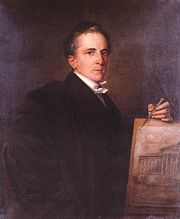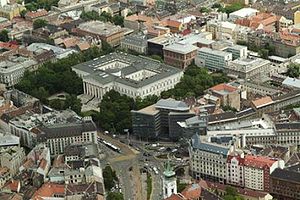
Hungarian National Museum
Encyclopedia
History
The Hungarian National Museum is said to have been founded in 1802 when Count Ferenc SzéchényiFerenc Széchényi
Count Ferenc Széchényi was the founder of the Hungarian National Library and National Museum in Budapest. The library is named after him the National Széchényi Library. He was the father of István Széchenyi.- References :...
set up the National Széchényi Library. This would then be followed a year later by the donating of a mineral collection by Széchényi’s wife. This led to the creation of the Hungarian National Museum as being a natural history museum, and not only a library. In 1807 the Hungarian National Parliament passed legislation on the new institution and asked the nation to help donate to the museum.
The Hungarian Parliament of 1832- 1834 helped with the growth of the museum as well. This parliament voted in favor of giving half a million forint to help with the construction of a new building for the museum. During this time the Hungarian National History Museum was officially set up under the Hungarian National Museum. Later in 1846, the museum moved to its current location of VIII. Múzeum krt. 14-16. Here the museum resides in a neo-classical style building designed by Mihály Pollack.

Hungarian Revolution of 1848
The Hungarian Revolution of 1848 was one of many of the European Revolutions of 1848 and closely linked to other revolutions of 1848 in the Habsburg areas...
. The Revolution was partially spurred by the reading of Sándor Petőfi
Sándor Petofi
Sándor Petőfi , was a Hungarian poet and liberal revolutionary. He is considered as Hungary's national poet and he was one of the key figures of the Hungarian Revolution of 1848...
’s 12 points
12 points of the Hungarian Revolutionaries of 1848
The 12 points were a list of demands written by the leaders of the Hungarian Revolution of 1848.-History:On the morning of March 15, 1848, revolutionaries marched around the city of Pest, reading Sándor Petőfi's Nemzeti dal and the 12 points to the crowd...
and the famous poem Nemzeti dal
Nemzeti dal
The Nemzeti dal , written by Sándor Petőfi, is the poem that is said to have inspired the Hungarian Revolution of 1848. Petőfi read the poem aloud on March 15 in Vörösmarty Square in Budapest to a gathering crowd, which by the end was chanting the refrain as they began to march around the city,...
on the front steps of the museum. This helped give the museum an identification as a major national identity for Hungary. In remembrance of the revolution two statues were added to the museum. The first is a statue of János Arany
János Arany
János Arany , was a Hungarian journalist, writer, poet, and translator. He is often said to be the "Shakespeare of ballads" – he wrote more than 40 ballads which have been translated into over 50 languages, as well as the Toldi trilogy, to mention his most famous works.-Biography:He was born in...
which was unveiled in 1883. Later in 1890 there was a statue next to the stairs of the museum of a memorial tablet to Sándor Petőfi. In addition during this time the Upper House of the parliament held its sessions in the Cereminial of the museum. This continued until the new house of Parliament
Hungarian Parliament Building
The Hungarian Parliament Building is the seat of the National Assembly of Hungary, one of Europe's oldest legislative buildings, a notable landmark of Hungary and a popular tourist destination of Budapest. It lies in Lajos Kossuth Square, on the bank of the Danube, in Budapest...
was built. Today in remembrance festivities for National Commemorations Day of 1848 are held in front of the museum.
In 1949 an act mandated that the ethnographic and natural history part of the Hungarian National Museum had to split off of the main museum. This also helped with the setting up of the modern day National Széchényi Library
National Széchényi Library
The National Széchényi Library is a library in Budapest, Hungary. It is one of the two Hungarian national libraries, the other being the University of Debrecen Library.-History:...
. All of these separate museums are still interconnected and other museums and monuments have become affiliated with them over time. The most recent addition was the Castle Museum in Esztergom
Esztergom
Esztergom , is a city in northern Hungary, 46 km north-west of the capital Budapest. It lies in Komárom-Esztergom county, on the right bank of the river Danube, which forms the border with Slovakia there....
that joined in 1985.
The Building
The building where the Hungarian National Museum is currently located was built from 1837-1847. The style of the main building was laid out in a neo-classical style and was added onto by other artists in the form of statues, paintings and other architecture. The statues of the Portico were done by Raffael Monti of Milan. One of these is a famous statue of the allegoric figure of Hungary, holding a shield with the Hungarian coat of arms on it. On the sides of this figure there is Science on one and Art on the other. In addition the paintings that have been in the staircase and on the ceiling since 1875 were done by Károly LotzKároly Lotz
Lotz Károly Antal Pál, or Karl Anton Paul Lotz was a German-Hungarian painter.- Career :Karl Lotz was born in Bad Homburg vor der Höhe, Germany, the 7th and youngest surviving child of Wilhelm Christian Lotz and Antonia Höfflick ...
and Mór Than
Mór Than
Mór Than was a Hungarian painter.Born at Bečej, he was educated in Italy and Vienna beside his cooperation with similar famous painters in his homeland. He worked in a realistic – pre-impressionist style. His subjects were mostly historic events and portraits but also mythological or...
. There has also been a garden that is used primarily for various concerts. Various artists have performed here including Ferenc Liszt. Today the garden is the venue of the Museum Festival.
Exhibitions
The Hungarian National Museum has seven permanent displays. The History of Hungary from the foundation of the state to 1990 Middle Ages is the first one that is mentioned. This display covers topics such as the age of the Arpads, the Turkish Age, TransylvaniaTransylvania
Transylvania is a historical region in the central part of Romania. Bounded on the east and south by the Carpathian mountain range, historical Transylvania extended in the west to the Apuseni Mountains; however, the term sometimes encompasses not only Transylvania proper, but also the historical...
and the royal Hungary, etc.
The Museum also covers Modern and Contemporary History. The history section here begins with the Rákóczi War of Independence, in the display it shows different sections of his military attire and various coins. The history section then ends with the rise and fall of the communist system in Hungary where the various politics are looked at. In another hall on the second floor one can find out about the Scholar Hungarians who made the twentieth century.
On one side of the first floor there is the exhibit: On the East-West frontier: History of the people of the Hungarian lands from 400,000 BC to 804 AD. This section then goes to look at various time periods between the Paleolithic period and the Avars. On the other side of the first floor is the Hungarian coronation mantle.
The ground floor’s permanent exhibit is focused on Medieval and Early Modern Lapidary. This exhibit looks at various stone relics and the carvings that have been made into them. The majority of the items in this collection were discovered during the 60’s and 70’s since they looked for more relics post World War II.
The final permanent exhibit is placed in the basement of the museum. This is the Roman Lapidary exhibit, which is a collection of old roman stones. These are mainly inscribed and carved and have some reference to Hungarian history
History of Hungary
Hungary is a country in central Europe. Its history under this name dates to the early Middle Ages, when the Pannonian Basin was colonized by the Magyars, a semi-nomadic people from what is now central-northern Russia...
.
Museum Information

The permanent exhibition is free of charge. Guided tours are offered.
Museum Address: 1088 Budapest, Múzeum krt. 14-16, Hungary
Museum Phone: (36-1) 338-2122, (36-1) 327-7749
See also
- Hungarian Natural History MuseumHungarian Natural History MuseumThe Hungarian Natural History Museum in Budapest, dating back to 1802, houses the largest natural history collections of Hungary and the region.-Foundation:...
- The Feleky CollectionThe Feleky CollectionThe Feleky Collection, acquired by the Library of Congress in 1953, consisted of more than 10,000 books and 15,000 periodical issues, including biographical files, newspaper clippings, questionnaires and other materials on approximately 920 Hungarian Americans, plus photographs, prints, music...
- Sevso TreasureSevso TreasureThe Sevso Treasure is a hoard of silver objects from the late Roman Empire, that may be illicit antiquities.The treasure trove consists of 14 large decorated silver vessels and the copper cauldron which contained them, and has been dated to the late fourth or early fifth century AD.Most notable is...
Sources
- Budapest Tourism Office
- Museum.hu, Homepage to the Hungarian Museums
- Museums in Budapest
- Hungarian National Museum

